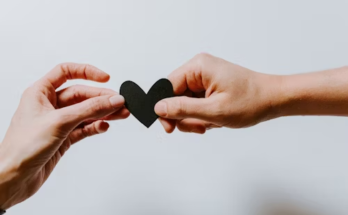
Marie Kondo suggests leaving sentimental items until last in your decluttering process, so as not to become distracted and end up with extra stuff you don’t need in your home.
Once you’ve achieved some major decluttering success, take on those sentimental items! Here are a few ideas to get you going:
- Donate
As a home organizer, I often assist clients in decluttering their homes and processing emotions associated with specific items. From fondue pots to childhood dresses, emotional attachments to belongings can prevent us from moving forward with living our best lives.
Unresolved emotions that have festered over time often cause emotional clutter. It could also arise from recent events or losses that have left you feeling unsettled, anxious, or overwhelmed. This is why it’s vital that we take the time to address these feelings directly before decluttering our home. Mindfulness practices, identifying triggers, and seeking assistance from trusted support networks have proven useful tools in combating emotional clutter.
Once you’ve taken care of the emotional clutter, it’s time to shed items no longer serving you. One effective way to do this is to donate them to a local charity or organization; doing so will allow you to feel good about releasing these things while ensuring someone will benefit from them.
People who struggle with decluttering often have difficulty parting with items, particularly when they have been sitting unused for an extended period of time. I advise my clients who find decluttering overwhelming to start by clearing smaller spaces like drawers, junk drawers, or linen closets where there may be less chance for sentimental attachment; this allows them to practice decision-making skills in a low-stakes environment.
Create short-term goals and reward yourself for meeting them to make the donation process simpler and the journey enjoyable and exciting! Positive reinforcement can make decluttering much less daunting; consider reaching out to a community or home organizer who can guide you through difficult decisions with fresh perspectives and offer support during the decluttering journey.
- Repurpose
Decluttering is about more than simply getting rid of physical items; it also involves letting go of emotional attachments. Although this process may be difficult, it is critical that we recognize that our feelings are valid and address them as part of the process. Doing this will enable us to better manage decision-making and declutter more efficiently.
Emotional clutter can be difficult to deal with on our own and often requires professional assistance. There are various forms of therapy available that can help declutter emotions and lead a more peaceful life, such as cognitive behavioral therapy (CBT), which helps identify and change negative thought patterns; psychodynamic therapy, which explores unconscious processes and unresolved conflicts; and mindfulness-based therapies, which promote emotional regulation.
Starting small is one of the best ways to tackle emotional clutter. Instead of undertaking to declutter all areas at once, start with decluttering individual drawers or closets without sentimental attachments; this makes deciding what stays and goes easier and can help keep motivation up while preventing overwhelm.
Finding and dealing with emotional baggage associated with clutter can be an arduous journey, so patience is crucial, as rewards will eventually pay off. Keep a positive outlook and stay patient; your rewards will make the journey worth your while!
Do not forget to set goals for yourself while decluttering; setting them can serve as motivation during this process. For instance, if a piece of clothing is difficult for you to part with, set yourself a goal to donate it by the end of this month. This will not only give you motivation but will also make you feel great knowing you did a good deed.
As part of your memory box strategy, it can also be beneficial to dedicate space for the most cherished keepsakes from your past. By doing this, you can honor them without cluttering up living spaces. Furthermore, these boxes may become valuable storage solutions in their own right!
- Recycle
Decluttering can be an emotionally charged experience. Parting ways with items no longer needed or desired may bring up memories, prompting guilt or grief feelings and forcing us to let go. But decluttering can be liberating in its own way!
When dealing with emotional clutter, it’s essential to have a concrete reason to purge things you no longer need or want. This could mean simply having enough space for all the items you use regularly or recognizing that certain possessions no longer bring value into your life. No matter what the motivation for decluttering is, writing it down and reminding yourself can keep you on the journey toward decluttering successfully, even if that changes over time!
If you’re having difficulty deciding how to dispose of your belongings, donate or recycle them instead of keeping them around as clutter. Not only will this benefit the environment by reducing waste production, but it will also make you feel good about parting ways with something once beloved; knowing they will have another life will ease any guilt attached to parting ways with an item you once valued.
Emotional clutter, just like physical clutter, can obstruct mental clarity as well as our ability to think clearly and make decisions. It may lead to feelings of anxiety, stress, and worry, which contribute to mental health disorders such as generalized anxiety disorder (GAD). When trying to tackle emotional clutter, it’s wise to take time for self-care; whether this means getting a massage, spending time with friends and family, or simply taking deep breaths in order to be present in each moment, this will help keep anxiety at bay and ensure you approach physical clutter with clear thinking.
- Store
If you have sentimental items that you no longer use in your home, consider finding a storage solution, whether that means placing them in a box in the basement, a shelf in your garage, or a cupboard in your kitchen. Clearing space by getting these things out of sight will allow you to see what exactly is in there and its location.
Part of your decluttering journey can be stressful and even emotional. To counteract these emotions and sadness, remind yourself of all of the benefits your decisions bring: by ridding yourself of unnecessary items, you’re making room for new experiences, relieving stress, and simplifying living space.
Make it part of your routine to review and curate your keepsakes on an ongoing basis, whether that means monthly, quarterly, or annual reviews of your collection, or setting aside specific time slots to do this review and evaluation process. It can help ensure it satisfies both your goals, space constraints, and emotional needs.
Although it can be painful to part with sentimental items, it’s important to remember that not everything should last a lifetime. If a particular piece no longer evokes positive memories for you, or if decluttering your space by giving items a second life through donation or giving to loved ones is no longer beneficial, consider giving those pieces a new life while decluttering and enjoying the remaining items.
Decluttering sentimental items may be difficult and challenging, yet it is essential if you want a more organized life. If you need assistance decluttering sentimental items, ask friends or family members for support and encouragement, or seek professional help, such as from a therapist or decluttering coach who can teach practical ways of managing both clutter and emotional attachments. Whatever decision you make, start decluttering today!



